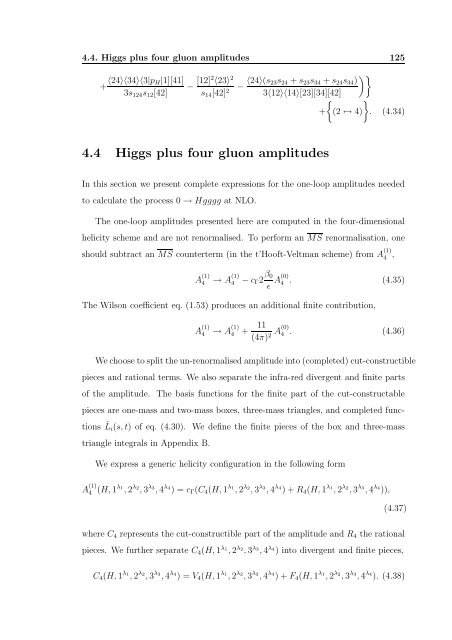Hadronic production of a Higgs boson in association with two jets at ...
Hadronic production of a Higgs boson in association with two jets at ...
Hadronic production of a Higgs boson in association with two jets at ...
Create successful ePaper yourself
Turn your PDF publications into a flip-book with our unique Google optimized e-Paper software.
4.4. <strong>Higgs</strong> plus four gluon amplitudes 125+ 〈24〉〈34〉〈3|p H|1][41]3s 124 s 12 [42]− [12]2 〈23〉 2− 〈24〉(s )}23s 24 + s 23 s 34 + s 24 s 34 )s 14 [42] 2 3〈12〉〈14〉[23][34][42]{ }+ (2 ↔ 4) . (4.34)4.4 <strong>Higgs</strong> plus four gluon amplitudesIn this section we present complete expressions for the one-loop amplitudes neededto calcul<strong>at</strong>e the process 0 → Hgggg <strong>at</strong> NLO.The one-loop amplitudes presented here are computed <strong>in</strong> the four-dimensionalhelicity scheme and are not renormalised. To perform an MS renormalis<strong>at</strong>ion, oneshould subtract an MS counterterm (<strong>in</strong> the t’Ho<strong>of</strong>t-Veltman scheme) from A (1)4 ,A (1)4 → A (1)4 − c Γ 2 β 0ǫ A(0) 4 . (4.35)The Wilson coefficient eq. (1.53) produces an additional f<strong>in</strong>ite contribution,A (1)4 → A (1)4 + 11(4π) 2 A(0) 4 . (4.36)We choose to split the un-renormalised amplitude <strong>in</strong>to (completed) cut-constructiblepieces and r<strong>at</strong>ional terms. We also separ<strong>at</strong>e the <strong>in</strong>fra-red divergent and f<strong>in</strong>ite parts<strong>of</strong> the amplitude. The basis functions for the f<strong>in</strong>ite part <strong>of</strong> the cut-constructablepieces are one-mass and <strong>two</strong>-mass boxes, three-mass triangles, and completed functionsˆL i (s, t) <strong>of</strong> eq. (4.30). We def<strong>in</strong>e the f<strong>in</strong>ite pieces <strong>of</strong> the box and three-masstriangle <strong>in</strong>tegrals <strong>in</strong> Appendix B.We express a generic helicity configur<strong>at</strong>ion <strong>in</strong> the follow<strong>in</strong>g formA (1)4 (H, 1 λ 1, 2 λ 2, 3 λ 3, 4 λ 4) = c Γ (C 4 (H, 1 λ 1, 2 λ 2, 3 λ 3, 4 λ 4) + R 4 (H, 1 λ 1, 2 λ 2, 3 λ 3, 4 λ 4)),(4.37)where C 4 represents the cut-constructible part <strong>of</strong> the amplitude and R 4 the r<strong>at</strong>ionalpieces. We further separ<strong>at</strong>e C 4 (H, 1 λ 1, 2 λ 2, 3 λ 3, 4 λ 4) <strong>in</strong>to divergent and f<strong>in</strong>ite pieces,C 4 (H, 1 λ 1, 2 λ 2, 3 λ 3, 4 λ 4) = V 4 (H, 1 λ 1, 2 λ 2, 3 λ 3, 4 λ 4) + F 4 (H, 1 λ 1, 2 λ 2, 3 λ 3, 4 λ 4). (4.38)
















